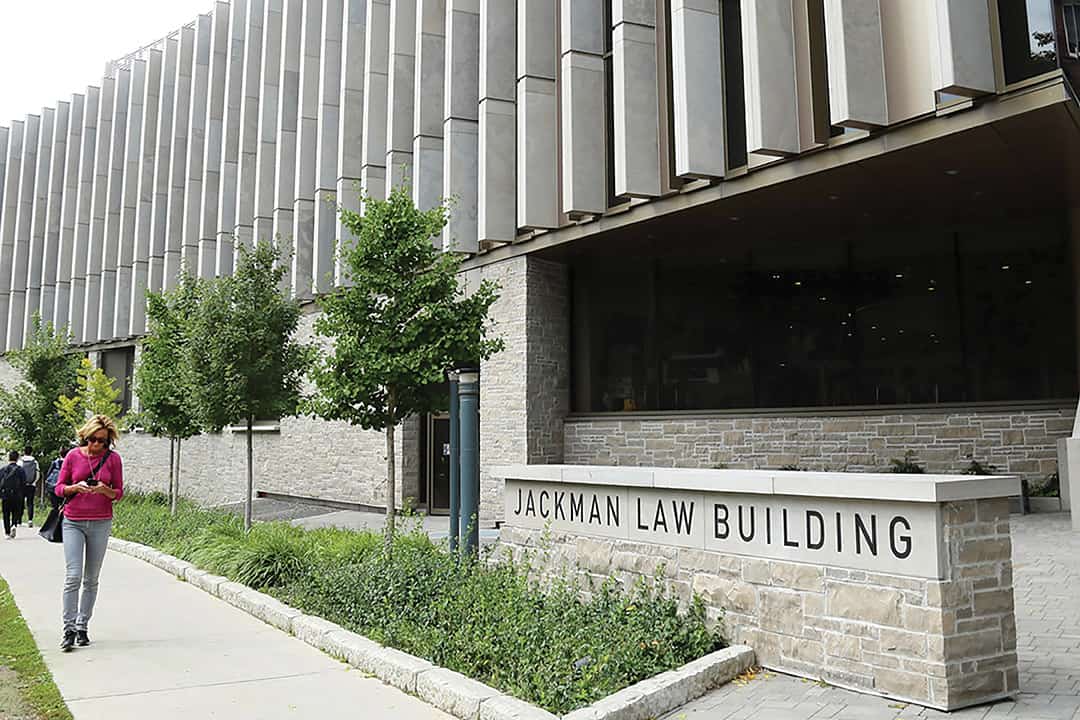Last month, first-year U of T law students criticized a final assignment for using “racial stereotypes” of Indigenous peoples.
The assignment featured a hypothetical situation where Indigenous children were taken out of the care of parents with substance use disorder and placed in foster care with a non-Indigenous family. After two years, the father, who had overcome alcohol use disorder, requested to see the children. The students were asked to write a memo on the situation, and take into consideration a 2017 Ontario law that prioritizes the maintenance of familial and cultural ties for Indigenous children.
Edward Iacobucci, Dean of the U of T law school, responded with an apology a week later. “I apologize whole-heartedly for the offence this assignment has understandably caused, especially to our First Nations and Métis students” wrote Iacobucci. “The faculty will consider means that we can adopt going forward to seek to ensure that something like this does not happen again.”
Looking closer at the assignment and the criticisms that it evoked, the initial problem wasn’t that the assignment was inherently stereotypical but that it was presented with a general lack of Indigenous awareness. Moving forward from this incident, U of T must incorporate more Indigenous awareness training for faculty and students.
There have been varying responses to this incident, from initial student complaints to the dean’s apology. In an interview with The Globe and Mail, Cindy Blackstock, Executive Director of the First Nations Child and Family Caring Society, shared her view, saying that there was nothing wrong with the assignment at its “face value,” because it was based on the fact that more than half of the children in foster care are Indigenous.
However, others argue that there should have been more engagement with experts in Indigenous law beforehand in order to avoid engaging with “troubling stereotypes,” as Iacobucci called them.
Indigenous voices are important in these situations, however, respecting Indigenous responses to this incident doesn’t necessarily ensure that something like this won’t happen again. Instead, there must be a concentrated effort toward increasing the base of Indigenous knowledge and awareness in the curriculum. By doing so, U of T would demonstrate a dedicated effort not only in reforming its own curriculum, but also in training a future generation of students whose actions will continue to remedy the gaps in our legal systems.
In an interview with, Iehnhotonkwas Bonnie Jane Maracle, a learning strategist at U of T’s First Nations House, expressed that she agreed with Blackstock’s initial impression, seeing this assignment as something necessary to educate students on the historical and ongoing oppression of Indigenous peoples in Canada.
“This is [a] fact… that’s the language of our lives, and if you’re going to be in law, you definitely have to be conditioned to what you’re going to be dealing with,” Maracle said.
However, as other students voiced in interviews with Law Times, the assignment came with a general lack of context, and should have considered the other harsher realities of the “whole story,” like “residential schools, the sixties scoop, [and] discrimination enabled by the Indian Act.”
Ironically, as Maracle also pointed out, the whole response to the article created an issue in itself, as the avoidance of issues related to Indig- enous peoples creates stereotypes.
In order to properly address reconciliation, we must train students, educators, and legal workers on the unique historical conditions which have shaped and reinforced the continued neglect of Indigenous peoples in Canada.
The need for integration of Indigenous content in our curriculum is made evident in a 2015 report, when the Truth and Reconciliation Commission (TRC) implored the Federation of Law Societies of Canada to provide “appropriate cultural competency training,” highlighting the “history and legacy of residential schools,” “treaties and Indigenous rights, Indigenous law and Indigenous-Crown relations,” and “training in conflict resolution and anti-racism,” as areas of concern.
In British Columbia, all lawyers will be required to take a six-hour course covering these areas starting in 2021. All other Canadian provinces should make a similar effort in order to provide competency and awareness training to law students, and other faculties of study. U of T must join this effort, and increase its own Indigenous awareness training.
Maracle noted that the response to the assignment exemplified the continued stereotyping of Indigenous peoples as the result of a direct lack of implementation of the TRC recommendations.
Ironically, as Maracle also pointed out, the whole response to the article created an issue in itself, as the avoidance of issues related to Indigenous peoples creates stereotypes.
“All they could see,” Maracle said, “was the stereotypical aspect of it, not the fact that this was a learning experience. A lot of people are now aware and treading very lightly on what they see… It prevents people from actually looking closer. And especially lawyers, but you have a job to do, to look beyond that and at the facts.”
This assignment was an opportunity for law students to fully immerse themselves in a case that affects numerous Indigenous families each year in Canada. Rather than focusing on the reality that is the disproportionate amount of Indigenous children in the foster care system, reactions have centred on criticizing this assignment as stereotypical and offensive. This hypersensitive reaction distracts from the reality of this systemic inequality. While it is important to reflect upon the way we talk about Indigenous issues, we must not forget that these issues persist regardless of the way we phrase them.
Instead of being quick to label things as stereotypical — and consequently silence debate and discussion altogether — we must focus on reforming our institutions and curriculums so that there is an increased quality and quantity of Indigenous awareness training within our faculty and society.
Toryanse Blanchard is a second-year English, Environmental Biology, and Book and Media Studies student at New College.


